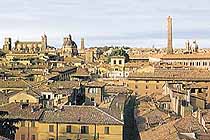Most large, modern cities quickly distinguish themselves upon first view, whether you’re flying overhead or driving in: New York City with its skyline, St. Louis with Eero Saarinen’s arch, Seattle with the Space Needle and so on. But it is rare to find older, more intimate cities that identify and distinguish themselves immediately upon entrance, without signage or symbols. We found one last week while in Italy-Bologna, a city of 400,000, located in the flat and frequently grey central Po Valley in the Emilia-Romagna region. This is a region known more for agriculture than for architecture. But Bologna’s design and visual character give a striking impact the moment one enters the main street, which is a mixture of age, classicism, humanity, irreverence, character and a ubiquitous earthy rose patina. In Italy, the city’s character is defined as la grassa, la dotta, la rossa (self-indulgent, smart and red). Bologna has had a history of being a progressive city since 1088, when the first university in Europe was founded there. It’s also been a centre for arts, legal scholarship, resistance during the German occupation and, of course, food, claiming mortadella, tagliatelle and tortellini among its innovations. Food is taken so seriously here that Bologna is said to be home to the Learned Order of the Tortellini, which has a formidable membership, all dedicated to the preservation of this traditional pasta.
-

-
The most striking design feature of Bologna is its arched passageways, which traverse the city and provide 23 miles of elegant community walkways. The beauty of these arches is that they were designed not just to look handsome, but to fill an important social function. This region is marked by heavy rainfall in the winter and intense heat in the summer. These elements are good for crops but not human interaction, for which the friendly Bolognese people are known. The covered archways allow the locals to casually stroll and mix with others without fussing with umbrellas, sunshades or other distractions. The system has the advantages of an indoor mall without any of the limitations or disadvantages. The nature of an arched walkway, as opposed to that of a flat-ceiling hallway, is such that it takes the eye upward in a celestial manner. The arches lift the spirit, like mini cathedrals for pedestrians, but you can’t get carried away with your gazing, as Bologna is also the dog capital of the region and curbing one’s pet is not a habit of the locals.
-
There are historic buildings and piazzas peppered throughout the city; some are singular monuments that rival many others in Italy, historically and architecturally. One gets the feeling that other Italian cities have worked to keep Bologna out of the spotlight. We learned that there is actually historical precedence for this. Construction of the amazing Basilica di San Petronio, which dates back to 1392, was halted by the Pope, who was apparently jealous of its scale. So now it sits, with massive brick construction over the finished marbled first floor, an utterly curious example of Western architecture. It’s as quirky as the bawdy Fontana di Nettuno and the tilting Due Torri. There are many contemporary works as well, such as the graphic installation celebrating Nazi resistance members that serves as a cultural precursor to Maya Lin’s Vietnam Veterans Memorial.
For more Bologna arches and architecture, go to http://www.dwr.com/images/newsletter/bologna3.html. -
Equally compelling about Bologna is the overall visual texture found on the Roman streets. Compositions of colours and surfaces dating back 1,500 years mix easily with contemporary living, as if Bologna were a laboratory for civilization. Small details awaken one’s eyes and senses to things that most of us do not normally see or notice, like a pleasantly decorated cappuccino in an alley café. It is easy to understand why the painter Giorgio Morandi was content with Bologna as his home and why the Pope may have worried about the sensual goings-on in this place, which Europe aptly designated as one of its Cities of Culture for the year 2000.
For more Bologna texture, go to http://www.dwr.com/images/newsletter/bologna4.html
Text courtesy of Design Within Reach















